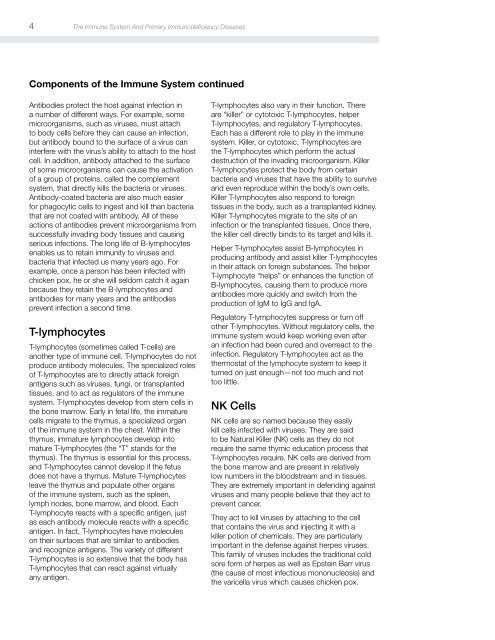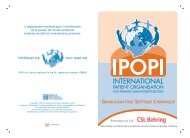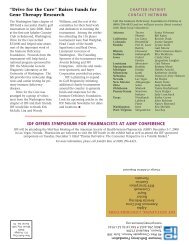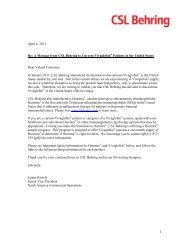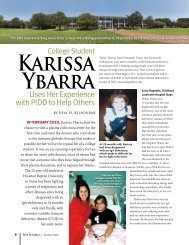IDF Patient & Family Handbook for Primary Immunodeficiency ... - IDFA
IDF Patient & Family Handbook for Primary Immunodeficiency ... - IDFA
IDF Patient & Family Handbook for Primary Immunodeficiency ... - IDFA
Create successful ePaper yourself
Turn your PDF publications into a flip-book with our unique Google optimized e-Paper software.
4 The Immune System And <strong>Primary</strong> <strong>Immunodeficiency</strong> Diseases<br />
Components of the Immune System continued<br />
Antibodies protect the host against infection in<br />
a number of different ways. For example, some<br />
microorganisms, such as viruses, must attach<br />
to body cells be<strong>for</strong>e they can cause an infection,<br />
but antibody bound to the surface of a virus can<br />
interfere with the virus’s ability to attach to the host<br />
cell. In addition, antibody attached to the surface<br />
of some microorganisms can cause the activation<br />
of a group of proteins, called the complement<br />
system, that directly kills the bacteria or viruses.<br />
Antibody-coated bacteria are also much easier<br />
<strong>for</strong> phagocytic cells to ingest and kill than bacteria<br />
that are not coated with antibody. All of these<br />
actions of antibodies prevent microorganisms from<br />
successfully invading body tissues and causing<br />
serious infections. The long life of B-lymphocytes<br />
enables us to retain immunity to viruses and<br />
bacteria that infected us many years ago. For<br />
example, once a person has been infected with<br />
chicken pox, he or she will seldom catch it again<br />
because they retain the B-lymphocytes and<br />
antibodies <strong>for</strong> many years and the antibodies<br />
prevent infection a second time.<br />
T-lymphocytes<br />
T-lymphocytes (sometimes called T-cells) are<br />
another type of immune cell. T-lymphocytes do not<br />
produce antibody molecules. The specialized roles<br />
of T-lymphocytes are to directly attack <strong>for</strong>eign<br />
antigens such as viruses, fungi, or transplanted<br />
tissues, and to act as regulators of the immune<br />
system. T-lymphocytes develop from stem cells in<br />
the bone marrow. Early in fetal life, the immature<br />
cells migrate to the thymus, a specialized organ<br />
of the immune system in the chest. Within the<br />
thymus, immature lymphocytes develop into<br />
mature T-lymphocytes (the “T” stands <strong>for</strong> the<br />
thymus). The thymus is essential <strong>for</strong> this process,<br />
and T-lymphocytes cannot develop if the fetus<br />
does not have a thymus. Mature T-lymphocytes<br />
leave the thymus and populate other organs<br />
of the immune system, such as the spleen,<br />
lymph nodes, bone marrow, and blood. Each<br />
T-lymphocyte reacts with a specific antigen, just<br />
as each antibody molecule reacts with a specific<br />
antigen. In fact, T-lymphocytes have molecules<br />
on their surfaces that are similar to antibodies<br />
and recognize antigens. The variety of different<br />
T-lymphocytes is so extensive that the body has<br />
T-lymphocytes that can react against virtually<br />
any antigen.<br />
T-lymphocytes also vary in their function. There<br />
are “killer” or cytotoxic T-lymphocytes, helper<br />
T-lymphocytes, and regulatory T-lymphocytes.<br />
Each has a different role to play in the immune<br />
system. Killer, or cytotoxic, T-lymphocytes are<br />
the T-lymphocytes which per<strong>for</strong>m the actual<br />
destruction of the invading microorganism. Killer<br />
T-lymphocytes protect the body from certain<br />
bacteria and viruses that have the ability to survive<br />
and even reproduce within the body’s own cells.<br />
Killer T-lymphocytes also respond to <strong>for</strong>eign<br />
tissues in the body, such as a transplanted kidney.<br />
Killer T-lymphocytes migrate to the site of an<br />
infection or the transplanted tissues. Once there,<br />
the killer cell directly binds to its target and kills it.<br />
Helper T-lymphocytes assist B-lymphocytes in<br />
producing antibody and assist killer T-lymphocytes<br />
in their attack on <strong>for</strong>eign substances. The helper<br />
T-lymphocyte “helps” or enhances the function of<br />
B-lymphocytes, causing them to produce more<br />
antibodies more quickly and switch from the<br />
production of IgM to IgG and IgA.<br />
Regulatory T-lymphocytes suppress or turn off<br />
other T-lymphocytes. Without regulatory cells, the<br />
immune system would keep working even after<br />
an infection had been cured and overreact to the<br />
infection. Regulatory T-lymphocytes act as the<br />
thermostat of the lymphocyte system to keep it<br />
turned on just enough—not too much and not<br />
too little.<br />
NK Cells<br />
NK cells are so named because they easily<br />
kill cells infected with viruses. They are said<br />
to be Natural Killer (NK) cells as they do not<br />
require the same thymic education process that<br />
T-lymphocytes require. NK cells are derived from<br />
the bone marrow and are present in relatively<br />
low numbers in the bloodstream and in tissues.<br />
They are extremely important in defending against<br />
viruses and many people believe that they act to<br />
prevent cancer.<br />
They act to kill viruses by attaching to the cell<br />
that contains the virus and injecting it with a<br />
killer potion of chemicals. They are particularly<br />
important in the defense against herpes viruses.<br />
This family of viruses includes the traditional cold<br />
sore <strong>for</strong>m of herpes as well as Epstein Barr virus<br />
(the cause of most infectious mononucleosis) and<br />
the varicella virus which causes chicken pox.


